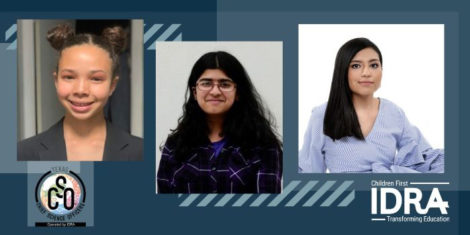• by Elizabeth Alexander, Shreya Chaudhary & Isela Herrera • IDRA Newsletter • June-July 2020 •


Initially envisioned by Dr. Jeremy Babendure, executive director of the SciTech Institute, the CSO program empowers middle and high school students to enrich school STEM culture and career awareness by bringing STEM-related opportunities to their schools and communities. The SciTech Institute brought the CSO program to Texas upon request by San Antonio CSOs Lexis Ratto and Kelly O’Kane. By the first full year in Texas, IDRA became the manager for the program in Texas and helped spread it throughout the state.
Before COVID-19
Before the COVID-19 pandemic, CSO students would start clubs, plan STEM-onstration days and lead other hands-on activities. Some examples include creating a FIRST Robotic Competition Club, running a STEM week, teaching others about STEM, and hosting a STEM night.
See Webinar Recording: Elevate the Voices of Students in STEM at Your School – Q&A on Hosting the Texas Chief Science Officer Program
For instance, for STEM nights, CSOs create activities for their peers and/or community to get excited about STEM. McCollum High School CSOs led their peers through a STEM experience to make ice cream in a bag while learning about chemical reactions. The CSOs had to account for not only who their audience was, but also the cost and number of items needed to make this activity. Moreover, CSOs organized this event with a principal and janitorial staff to set up in a space that is easily visible for students to see what is happening.
The goal for action plans like this is to enrich the STEM culture at our schools and communities.
As for how we collaborated, we mostly interacted with our fellow CSOs at the campus level and local cabinet meetings. Multiple CSO groups met in January for a regional cabinet meeting. The meeting featured excellent guests, such as a women in mathematics panel and a civic engagement activity for CSOs to look into careers in STEM fields. Students also had a working lunch session where we could connect with other CSOs’ ideas and past experiences. By using this collaboration as a stepping stone, many CSOs were inspired by what other students were doing.
During COVID-19
With COVID-19’s social restraints, CSOs adapted their action plans and spread STEM awareness and knowledge in different ways. Connecting through the internet, CSOs adapted and created new action plans. Some plans included hosting hackathons, organizing scientists to speak on Zoom calls, and creating other online opportunities for students.
See Webinar Recording: Chief Science Officer Students Determined to Promote STEM Despite School Closures
For example, CSO Shreya Chaudhary created a Discord BellBot for her peers to alert them while they do schoolwork at home, as a school bell would. This cue reminds students to transition to the next subject’s coursework and also gives them quick links to their teachers’ online platforms and assignments. BellBot enables students to document each day’s homework, like the group to-do list, to ensure everyone is doing the correct homework.
This is one of many innovative projects our Texas CSOs are creating and sharing as a response to COVID-19. CSOs didn’t look at COVID-19 with despair and view it as a hindrance; rather, we used our knowledge and skills to reach broader audiences.
Not only did the CSO students adapt, but the entire international CSO organization also expanded its online resources, connecting CSOs on an international scale. We collaborated with other CSOs internationally via weekly Zoom calls. CSO students talked about recent events in their community and how they were coping with social distancing. We also connected emotionally with people from diverse cultures around the world. We talked with scientists worldwide, ranging from engineers to biologists.
Hear Classnotes Podcast Episode: Meet the Chief Science Officer Students Who Brought the Program to Texas
The advantage of these calls is the ability to see how other people are also deeply invested in STEM. With the diverse network pool, our students from Texas can reach out to people from all across the world and talk with students in Mexico and Kuwait.
“Having connections across the globe has personally helped me feel a sense of warmth as of late despite all the negativity that is happening around the world during this pandemic,” CSO Isela Herrera said.
Hope in a Time of Crisis
During tough times like these, the entire world is searching for something. Something to take their minds off of the pain that we are seeing all around us. What we are searching for is a four-letter word: Hope.
While hope is something we need at the CSO program, we don’t just look for hope; we create hope within our communities. The CSO motto is, “Don’t just hope it happens; make it happen!” With the COVID-19 pandemic, CSOs refuse to sit around and twiddle our thumbs, hoping for the epidemic to pass.
CSO Elizabeth Alexander said, “As a Chief Science Officer, I am proud of the lasting impact we as an organization have left and will continue to embark on the world.”
We have CSOs using their knowledge to find potential cures, CSOs working on maintaining the mental health of others. Overall, despite all of the despair COVID-19 has brought, we as an organization of students have decided to make sure to stay connected, innovate and grow as a community.
In 2019-20, CSO Isela Herrera was a 12th grader at McCollum High School in Harlandale ISD, San Antonio. CSO Shreya Chaudhary was a 10th grader at the Keystone School in San Antonio. CSO Elizabeth Alexander was an eighth grader at STEM Academy in Northeast ISD, San Antonio.
[©2020, IDRA. This article originally appeared in the June-July 2020 IDRA Newsletter by the Intercultural Development Research Association. Permission to reproduce this article is granted provided the article is reprinted in its entirety and proper credit is given to IDRA and the author.]


